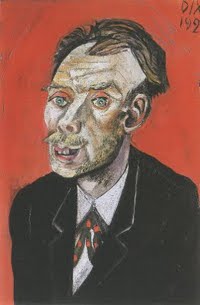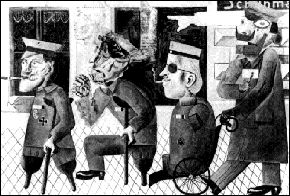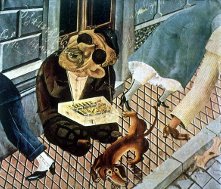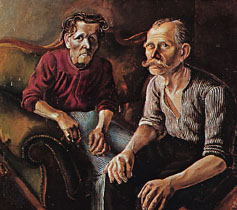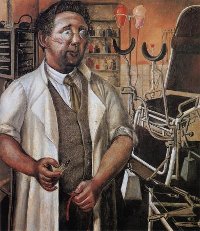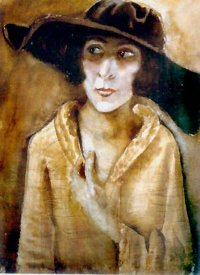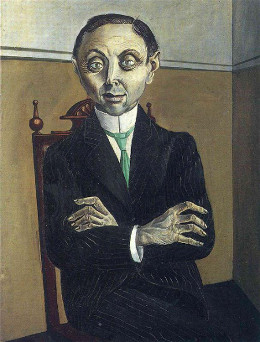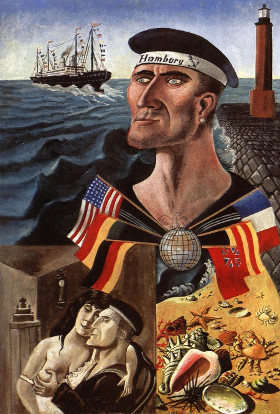Portrait of Max John
Year: 1920
Description: Fritz Glaser was a wealthy Jewish lawyer and a modern art collector. That was two strikes against him when the Nazis came to power. He survived the Holocaust but his art collection was scattered. After the war he tried to track it down. This piece was hidden in plain sight at the Freiburg Museum of Modern Art. The museum bought it at auction from a private collector in 1959. Glaser may have sold it under duress as financial pressures mounted as a result of his racial persecution but the Freiburg Museum appears unwilling to further investigate and confirm its provenance.
Provenance: Freiburg Museum of Modern Art
The War Cripples
Year: 1920
Description: By 1920, Dix was associated with the Berlin Dadaists. In the summer of that year, he exhibited this painting at the First International Dada Fair. Unlike many works on display, this one avoided official controversy despite its accusatory tone. Other works were not as fortunate. The military filed charges of insult against several artists at the exhibition.
So while it may have escaped the military's ire during the Dada Fair, it become a lightening rod the following winter when Paul F. Schmidt purchased it for the Dresden Museum. Later when Hitler came to power, it was seized and displayed in the Nazi's Degenerate Art exhibition. It was captioned, "Slander against the German Heroes of the World War."
In this painting, Dix leaves no one unscathed. He damns the military for butchering his generation, the public for its fascination with these reconstituted men and the cripples themselves for their undiminished national pride.
The reproduction seen here was taken from a period photograph. The War Cripples disappeared after the Degenerate Art exhibition. It's location is currently unknown and it is presumed destroyed.
Provenance: Location unknown
- This is a photographic reproduction of a halftone image; the actual painting is presumed destroyed
- First International Dada Fair (1920)
The Match Seller
Year: 1921
Description: This mutilated veteran is a pitiful character. The war has taken limbs and vision. His deformities are highly visible yet the only attention he draws is from a Daschund who pees on his stumps.
Provenance:
Parents of the Artist
Die Eltern des Künstlers I
Year: 1921
Description:
Otto Dix was the son of working class parents. His father Franz was a foundry worker and his mother Louise was a hausfrau.
Provenance: Öffentliche Kunstsammlung
Doctor Hans Koch
Year: 1921
Description: Doctor Koch was a kidney and bladder specialist in Dusseldorf. He is depicted in a menacing chamber of medical equipment. Dix befriended the Doctor then took Frau Doctor to his bed. When Dix returned to Dresden, Martha Koch followed him. She left her husband and two children behind. The Doctor was unperturbed because he had already begun an affair with Maria Lindner, his wife's older sister. Dix and Koch became brothers-in-law and remained friends until the Doctor's death in 1952.
Provenance: Museum Ludwig, Cologne
Frau Doctor Hans Koch
Year: 1921
Description: Unlike its European counterparts, the German middle class did not seek distinction granted by royalty. Before the War, for example, Oscar Huldschinsky refused the Kronenorden by saying, "If no one has thought to honor my contribution to German Industry, I'm not going to accept a medal just because I went boating with the Kaiser." The title most sought by businessmen was Kommerzialrat. For lawyers it was Justizrat. Such titles were so coveted that wives were often addressed with their husband's title, hence Frau Doctor Hans Koch. "Doctor" was removed when she became Frau Dix.
Provenance: Museum Ludwig, Cologne
The Salon I
Year: 1921
Description: Four prostitutes sit around a table and wait for business. Each is past her prime; they all wear cheap finery which fails to hide their years. What opportunities are there for aging prostitutes? (Salon II was lost or destroyed).
Provenance: Kunstmuseum Stuttgart
Portrait of Paul F. Schmidt
Bildnis Paul F. Schmidt
Year: 1921
Description: Paul F. Schmidt was a German museum director and art critic. He was a forward-looking man who admired modern artists. In his first full-time assignment as the head of municipal art collections in Magdeburg, he attempted to fill the print room with young German and French artists. The backlash from an older generation was swift and heavy. Schmidt quit the museum when his vision was dashed.
From Magdeburg he moved Munich before settling in Dresden as the director of modern art in the City Museum. In 1921, he published Dix's Radierwerke I and II. Such progressive purchases put him in the cross hairs of local right-wing politicians. When the NSDAP seized power in 1933, he was forced into retirement. He was thus one of the first victims of Nazi cultural policy.
Schmidt moved to southern Germany before the Second World War where he faded to obscurity. Yet he was a large figure in early 20th Century German art. This portrait, which is both charming and grotesque, is a delightful reminder of his legacy.
The F. in Paul F. Schmidt stands for "Ferdinand."
Provenance: Public Museum
- Staatsgalerie, Stuttgart, Germany
Woman With A Red Hat
Frau Mit Roten Hat
Year: 1921
Description: This painting is widely distributed in digital form under the name Così fan tutte, Women Are Like That. While that is certainly apt, we list it under the name in Fritz Löffler's Euvre der Gemälde.
Her cheeks are rosy red and her lips are darkly stained. Yet her skin complexion suggests she's not as healthy as those colors suggest. Heavy makeup creates the illusion of vibrant health. Così fan tutte
Provenance: Private Collection
- Hamburg
- Löffler 1921/11
Farewell To Hamburg
Abschied von Hamburg
Year: 1921
Description: In the summer of 1921, Otto Dix visited the port city of Hamburg on the North Sea. As he walked along the waterfront, he saw sailors on leave as they searched for pleasure on land. Along the red light district, Dix found brothels and prostitutes in abundance. It was a scene that may have helped reinforce earlier prejudices.
During the war, Dix often held sailors in contempt. The High Seas Fleet was in harbor for much of the conflict. From the artist's perspective, its sailors were chasing prostitutes and drinking gratuitous amounts of alcohol while the Wehrmacht bore the brunt the war's burden.
Dix's interpretation of a sailor's life as a string of exotic encounters has been described by Ashley Bassie in Expressionism as "intentionally kitch." A sailor's longings last as long as the time between ports of call.
Provenance: Private Museum
- Gunzenhauser Museum, Chemitz (2007)
- Galerie Gunzenhauser, Munich
- Löffler 1921/1
-
Björn Sjöling
-
http://radarman1946.tumblr.com/ Melvin
-
Alice Rohr
-
Richard Foran
-
Richard Foran
-
Richard von Bitter
-
Karl Gauss
